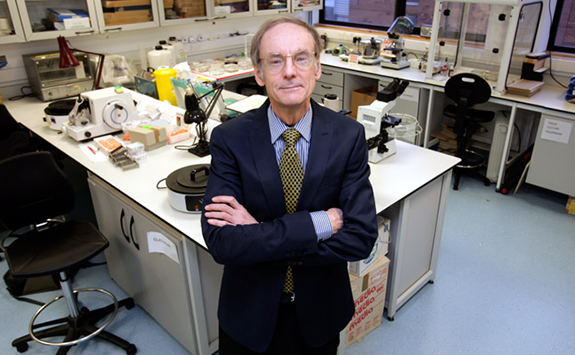Fat jabs, food and health: Newcastle diabetes expert ‘weighs in’ on the rise of Ozempic
In recent years, there has been a growing trend of medications initially used for type 2 diabetes being prescribed and promoted as weight loss wonder drugs. What is the role of these new magic medicines and where is the field of weight management heading?
1 September 2025
Are appetite-suppressing injections like Ozempic and Mounjaro all they claim to be?
“The weight just fell off me!” This is a familiar quote from people taking one of the new, powerful appetite suppressants (such as Ozempic and Mounjaro). But increasingly other voices join in: “I’ve never been so sick in my life”; “I’ve put all the weight back on.”
In recent years, there has been a growing trend of medications initially used for type 2 diabetes being prescribed and promoted as weight loss wonder drugs. Medications such as Ozempic and Mounjaro have been hailed as the holy grail by celebrities and social media influencers, leading to a surge in demand (there has been a reported 5,000% increase in Ozempic prescriptions from 2018 to 2023) and shortages for diabetes patients.
What is the role of these new magic medicines and where is the field of weight management heading? In this blog, world-leading diabetes researcher Professor Roy Taylor weighs in.
Roy, Emeritus Professor of Medicine and Metabolism at Newcastle University, has been researching type 2 diabetes for almost 50 years, with his work leading to a system used to screen for diabetic eye disease – majorly reducing the cases of blindness due to diabetes in the UK – and more recently, the discovery that type 2 diabetes is reversible with sufficient and sustained weight loss.

The mechanics of fat build up
How does too much fat accumulate in your body? It really is simple in mechanistic terms. All foodstuffs are made of carbon atoms in various configurations. Your remarkable liver will sort digested foods and supply the rest of the body with whatever it needs. If not immediately needed, protein will be turned into carbohydrate and carbohydrate into fat. Some foods are compulsively delicious – as manufacturers of processed foods know – and overconsumption can be difficult to avoid. Year on year, the cumulative effect becomes obvious.
There has been an evolutionary imperative for us to carry stores of energy to tide us over during unsuccessful hunting, crop failures and famine. Carbohydrate stores are limited, lasting only 1-2 days during starvation. This is the ‘current account’ of energy management for everyday use, but only short term. The ‘savings account’ for rainy days must be in the form of fat, a highly efficient way of storing energy. And ‘subcutaneous fat’ is safe – by itself it does not have harmful metabolic effects. Long term problems start to stack up when the capacity of this safe depot is exceeded. Its size is genetically determined, with some people unable to store more than a thin layer and others able to store prodigious amounts. But when this storage is full, any daily excess of food has to be stored somewhere. It builds up inside the abdomen and inside the major organs. These fat depots are far from safe and lead to many metabolic problems, including type 2 diabetes and heart disease.
We have not evolved any system to detect overly filled fat stores which can dampen down appetite. A design fault has been revealed.
Most bodily systems have checks and balances. If something is in excess, the regulating factors cut in and compensate. Your body is amazing at self-regulation. But 225 million years of mammalian evolution with 300,000 years of human evolution has produced no pressure to develop a mechanism to oppose appetite, in contrast to the reality of marginal food supply. From the point of view of our current food environment, a design fault has been revealed.
Appetite is a genetic luck of the draw
As a medical student in the early 1970s, I was fascinated by the clear thinking and logical deduction expounded by Reginald Passmore, Professor of Physiology in Edinburgh, in predicting that there had to be a blood-borne substance which affected eating behaviour. Decades later, leptin was identified with dramatic consequences for the very small number of children born with leptin deficiency. They have prodigious appetites and become very heavy from an early age.
In Newcastle, we have a historical link to such a condition. William Campbell (1856-78) was landlord of The Duke of Wellington pub on High Bridge (still open). He eventually weighed 52 stone (330kg). Most tellingly, at the age of 9 months he weighed 3 stone, and 18 stone by the age of 10 years. Had he been born today, regular injection of the missing leptin would have restored him to complete normality.
These naturally occurring extreme phenomena can throw light on similar, but much less severe tendencies in everyone. Injecting leptin into people who are classified as ‘obese’ has no effect at all, as it is just one of many appetite regulators determined by a large number of variants in many genes. We are all individuals, and appetite is best regarded a characteristic with a wide spectrum of manifestations. Other influences play a part in determining the amount of food consumed, but none has such a profound effect as an individual’s genetic luck of the draw.
Suppressing our appetite medically
The present highly potent ‘fat jabs’ act upon more than one site in the brain’s appetite regulating centres. A second completely different site of action is on the stomach itself as they slow down the rate of stomach emptying, leaving a feeling of fulness lasting for much longer than usual. Overall, the ability to move a person’s typical appetite downwards along this spectrum of intensities is an amazing new tool. At one end of the spectrum there is ‘ravenous,’ moving down through ‘hungry’ to ‘not hungry’ to ‘frankly nauseated’. No wonder that on starting treatment with these medicines, many experience nausea, and in some cases, severe vomiting.
Around half of all those on these new drugs stop taking it in the first year due to nausea, vomiting or other side effects.
Most older studies of dietary restriction achieved only 2-3kg weight loss, and it was a similar show with earlier appetite regulating drugs, well short of the 10-15 kg weight loss needed to affect metabolic health. Then Semaglutide (Ozempic or Wegovy) burst onto the market offering 10-15kg weight loss, and now Terzepatide (Mounjaro) promises 15-20kg weight loss, acting as it does on three sites in the brain.
But a note of caution. The headlines tend to repeat the weight loss shown in trials to prove efficacy, but these trials have been designed by pharmaceutical companies to give best possible impressions. Also, any trial will give results which are better than those possible in the real world because only interested people are recruited and they receive major support in other ways.
Real world information is beginning to emerge. Around half of all those started on treatment of these new drugs stop taking it in the first year due to nausea, vomiting or other side effects. Overall, achieved weight loss is likely to average 50-65% of that seen in the tightly controlled trials. This is still phenomenally useful on average, and naturally some people do much better than the average.
How should these new appetite regulators be used?
Cost is a major practical determinant of this. The current NHS cost of Terzepatide is £122 per month. The direct cost to the NHS of obesity is said to be around £6.5 billion annually, but the real cost of dealing with the complications associated with obesity is many times greater than this. Doubtless it was such a calculation which led to its current NHS approval for people with obesity and 4 complications (easily clocked up). But it is to be used for one year only and we know that regain of weight is very rapid on withdrawing the drug.
Taking a step back, it can be seen as odd trying to use drugs to deal with a problem which is clearly environmental. The genetic make-up of the population has not changed much over the last few millennia, let alone the last 50 years which has seen an explosion in weight following the rise of processed foods after the second world war, when the food industry was charged with feeding the population in a cost-effective manner (and outperformed their brief!)
The direct cost to the NHS of obesity is said to be around £6.5 billion annually, but the real cost of dealing with the complications associated with obesity is many times greater than this.
Reminiscent of the tobacco industry, intense lobbying and media campaigns are used to obscure the effects of the current lack of regulation of food. The insidious battle against the soft drinks tax is a case in point. This legislation has been dramatically effective because it was aimed at forcing manufacturers to reformulate, decreasing sugar content. 45,000 tons of sugar have been removed from UK national consumption annually and the rate of childhood obesity has decreased significantly. But misleading content is pumped out online and elsewhere, such as pointing out that ‘obesity rates have not changed’. That is true for the whole population but not for the target population of consumers of soft drinks – children.
The soft drinks levy is just a toe in the water for more effective regulation of processed foods, including ready meals and takeaways. Those who cry ‘Nanny state’ need to consider the increased taxes they must pay to deal with obesity.
Lessons from 50 years of research
If the current problem of many people being heavier than optimal for their own body is caused by eating more than required, can it simply be set right? That was the question that emerged from my own research. I’d been trying to understand just how the muscles, liver and fat cells dealt with food so effectively in normal health and how these processes went wrong in type 2 diabetes.
Type 2 is the kind of diabetes that comes on in adult life. It is very different from type 1 diabetes, a condition typically of childhood and early adult life caused by an autoimmune destruction of insulin producing cells not at all related to diet and lifestyle. After years of taking out biopsies of fat or muscle tissue to study in the lab, advances in the use of magnetic resonance methods were developed and the state-of-the-art Newcastle Magnetic Resonance Centre was established. This allowed the study of glucose and fat inside the major metabolic organs of the body. Suddenly we were able to do repeated measurements and to track movement of foods in real time without discomfort to volunteers.
Specialists had long thought that type 2 diabetes had multiple causes and was ‘complex and heterogenous’. But there was a simple potential solution: A build-up of fat within the liver caused by a little too much food over a long period interfered with glucose handling and caused too much fat to be produced by the liver – which would interfere with insulin secretion from the pancreas.

Our discovery was published as the twin cycle hypothesis in 2008 and we then set about designing a counterpoint study to prove this outrageous concept that predicted that type 2 diabetes could be reversed to normal if 15kg weight loss was achieved. All doctors knew this to be impossible – or thought they did.
We were challenged with devising a diet to achieve 15kg weight loss, but one that would suit most people. Having been listening in my clinic for decades to descriptions of the very genuine reasons why weight loss was difficult, I knew we had to minimise the difficult matter of choice of what and how much to eat, and to minimise hunger. One packet of a liquid formula complete diet for each main meal plus a large helping of non-starchy vegetables for only 8 weeks should do the job. It did.
People in the study lost an average of 15.3kg and all the magnetic resonance and other tests confirmed the predictions of the twin cycle hypothesis.
None of this is anything to do with ‘obesity’. If a person has type 2 diabetes that means that they have become too heavy for their own constitution even if their BMI is ‘normal’.
hat was 2011. A series of further studies has extended knowledge: remission of type 2 diabetes is most likely to be achieved in short duration (less than 6 years) since diagnosis; remission lasts as long as weight is not regained; and the small, shrunken pancreas typical of the condition returns to normal size and shape.
None of this is anything to do with ‘obesity’ and BMI, useful for epidemiology but irrelevant to you and me. Only around 50% of people developing type 2 diabetes are obese. We have now tested the personal fat threshold concept – and we can state that if a person has type 2 diabetes that means that they have become too heavy for their own constitution, even if their BMI is in the ‘normal’ range derived from population studies.
As a result of this research, the NHS Type 2 Diabetes Path to Remission programme has just been rolled out across the country and I have published a book to support those looking to manage their diabetes. In the first year, average weight loss was 10.3kg and around a third of people achieved remission off all tablets for diabetes.
The problem of a population rapidly gaining weight is a result of food supply and policy, and this basic issue must not be forgotten.
Drugs vs diet
Do the new drugs supplant the need to use the dietary method of losing 15kg? Certainly not. People describe the moment of being told they have type 2 diabetes as a hammer blow. A substantial number of people want to be free of drugs, free of medicalisation and to regain their health. The ‘Newcastle diet’, as the newspapers called it, achieves this. The dietary method shows individuals how much they need to eat to keep their own body at a steady weight and consequently, the rate of weight gain after the weight loss phase of the programme is much less than after a course of the new magic weight loss drugs.
The problem of a population rapidly gaining weight is a result of food supply and policy, and this basic issue must not be forgotten. Certainly, the powerful appetite suppressant drugs are effective when used in a targeted manner and will benefit some people. But we are at a very early stage of learning how best to use them and what the long-term side effects may be.


